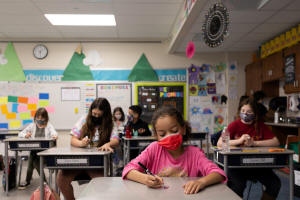U.S. schools turn focus to mental health of students reeling from
pandemic
 Send a link to a friend
Send a link to a friend
 [May 06, 2021]
By Maria Caspani and Hannah Beier [May 06, 2021]
By Maria Caspani and Hannah Beier
OREFIELD, Pa. (Reuters) - As COVID-19
upended education during the past year, Pennsylvania middle school
teacher Jennifer Lundberg often began her English lessons gauging the
mental wellbeing of her students.
Sometimes, she would turn the lights off and dedicate a few minutes of
in-person class to walking the kids through exercises that asked them to
identify stressors they were experiencing.
With her own teenage daughter suffering from bouts of depression and
anxiety brought on by the pandemic, the veteran teacher saw evidence all
around her of the urgent need for mental health support for young
people.
"They are struggling in a way that I feel like a lot of times they don't
even have words for," Lundberg said. "I've had students who have left in
the middle of the day to go to the ER to get evaluated."
Lundberg teaches in the Parkland School District in Allentown, where
school officials said the coronavirus has been a catalyst for getting
better mental health training for staff and care for its more than 9,000
students.
Educators across the country agreed students' mental wellbeing became a
bigger priority after the pandemic forced schools to shut down or
operate with a mix of remote and in-person learning. Some students
struggled to focus, and isolation, worry and depression took a toll on
many.

A Reuters survey earlier this year of U.S. school districts serving more
than 2.2 million students found that a majority reported multiple
indicators of increased mental health stresses among students.
Those concerns have led to a flood of new funding and initiatives aimed
at helping schools navigate the pandemic's aftermath.
The federal COVID-19 relief package included $122 billion for K-12
schools to implement "strategies to meet the social, emotional, mental
health and academic needs" of the hardest-hit students. President Joe
Biden's budget proposal released in April includes another $1 billion to
add nurses and mental health services in public schools.
In Utah, a bill signed in March makes mental health a valid excuse for a
school absence. Similar legislation has been introduced in other states
including Connecticut and Maryland.
Next month, the National Center for School Mental Health will launch
ClassroomWISE. The free online course will train U.S. teachers and
school staff on how to create a safe and supporting classroom
environment, and how to support students with mental health concerns.
Districts nationwide have said the pandemic "has kind of given them a
vitamin D shot" in terms of awareness and resources, said Sharon Hoover,
co-director of the government-funded center. Sustained focus will be
needed for success, she added.
[to top of second column]
|

Samantha Wiik's fourth grade class does an activity comparing the
positive outcomes of the coronavirus disease (COVID-19) to their
word of the week, "celebration" at Kratzer Elementary School in
Allentown, Pennsylvania, U.S. April 13, 2021. Students drew on their
desks to visually portray this idea with dry erasable markers.
Picture taken April 13, 2021. REUTERS/Hannah Beier

"We'd be kind of kidding ourselves if we think
everyone's going to walk into school doors and things go back to
normal," Hoover said.
FRESH MOMENTUM
Many districts still lack sufficient resources and training,
however. And experts say even where there are protocols and
initiatives already in place, the severity and novelty of some
circumstances amid the pandemic pose challenges.
Amy Molloy, the director of school mental health resources at the
non-profit Mental Health Association in New York State, said she
thought the state's schools were well-positioned to attend to
students' mental health thanks to legislation passed in recent years
before COVID-19 hit.
But the toll of the pandemic is hard to predict.
"There's a lot of concern and uncertainty about what kind of trauma
experiences, what kind of grief and loss, what kind of enhanced
mental health problems... are students bringing back," Molloy said.
Before the coronavirus, insurance roadblocks had hampered the
Parkland School District's efforts to provide students with
one-on-one psychotherapy sessions for their mental health needs,
said Brenda DeRenzo, the director of student services.
The pressure created by COVID-19 allowed the Pennsylvania district
to finally overcome the financial hurdles through a partnership last
fall with a local hospital that linked its middle and high school
students with licensed clinicians.
This fall, when students return to full-time in-person learning, the
district will implement programs to help them readjust to school and
reconnect with their peers.
One initiative will link students to community outreach programs
such as a food drive or a nursing home in an effort to rebuild the
camaraderie lost to the pandemic, DeRenzo said.
Lundberg, who teaches at Orefield Middle School, said she plans to
start hosting morning meetings with parents to facilitate more
communication about how their children are coping.
"These kids are good kids, they're just done; they're burned out,"
she said.
(Reporting by Maria Caspani and Hannah Beier in Orefield,
Pennsylvania, Editing by Colleen Jenkins and Cynthia Osterman)
[© 2021 Thomson Reuters. All rights
reserved.] Copyright 2021 Reuters. All rights reserved. This material may not be published,
broadcast, rewritten or redistributed.
Thompson Reuters is solely responsible for this content. |